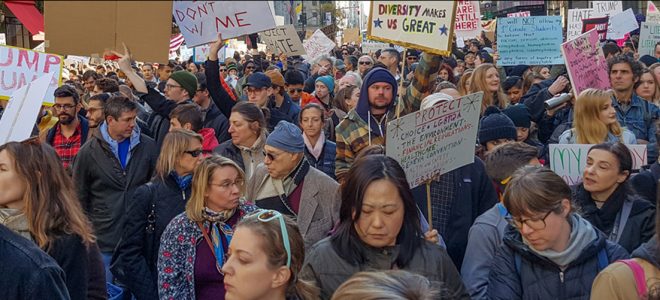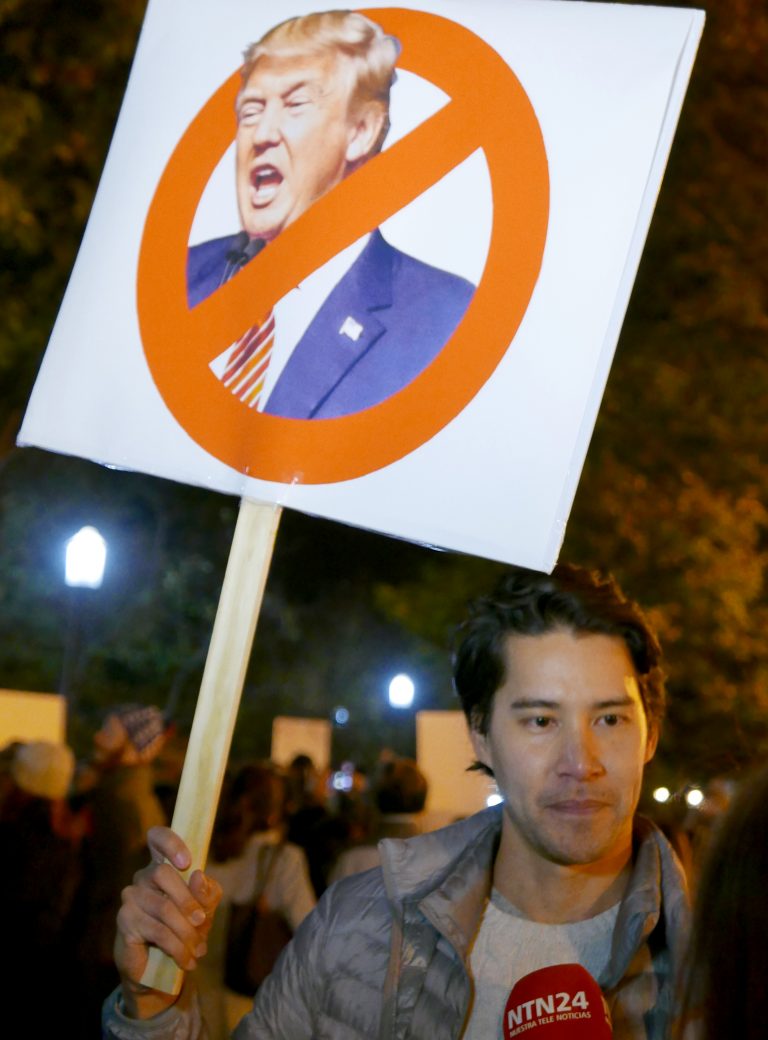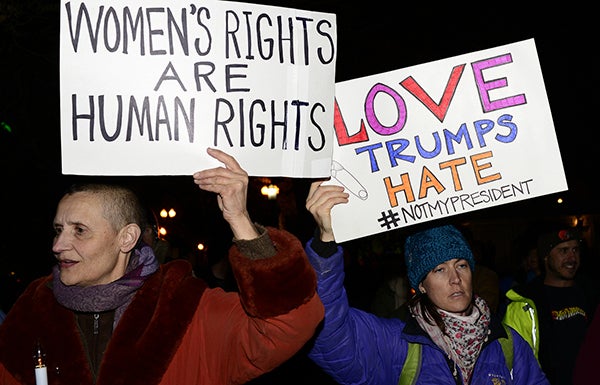

Julie VanDusky-Allen received her PhD in Political Science in August 2011 from Binghamton University. She currently teaches courses in comparative politics, American politics, and research methods. With respect to research, she focuses mostly on how political parties adapt to institutional limits on their power. She also examines how US troop deployments influence foreign policy decision making in other countries. Additionally, Julie received a Fulbright research scholarship to gather data and teach in Mexico City during the 2008-2009 academic year.
In the days immediately following Trump’s victory in the U.S. presidential election, tens of thousands of people protested against Trump’s victory throughout the country. Many of these protests took place outside Trump’s properties. Celebrities even took part. While most of these protests were peaceful, in some cases, protesters blocked traffic, threw Molotov cocktails, set flags on fire, beat up a Trump piñata, and a few people were arrested. As a result, security has been tightened at Trump’s properties.
Many of Trump’s supporters (including Trump himself) were perplexed by this recent protest behavior. However, it becomes more understandable based on recent research on the effect of election outcomes on democratic satisfaction and protest behavior. Below I will discuss how this research can explain what is going on in the US today. Here is a brief summary of this post: People who voted for parties that do not win office are less likely to be satisfied with democracy than people who voted for parties that do win office. As a result, the people who voted for the parties that did not win are more likely to protest. This is especially the case when the party they did not vote for controls both the executive and legislature. Applying this logic to the most recent election, since the Republicans now control the House, Senate, and the Presidency, Democrats will be more likely to protest than they were under Obama. In addition, other factors such as polarization, disproportionate election results, and concerns over civil liberties should make Democrats highly likely to protest in the next two to four years.
SATISFACTION WITH DEMOCRACY

Not surprisingly, the extent to which voters are satisfied with democracy is in part influenced by whether the party they voted for took control over the government. Election “winners” (or voters who voted for parties that controlled the executive and/or legislature) tend to be more satisfied with democracy than election “losers” (or voters who voted for parties that did not become party of the executive and/or did not control the legislature). Winners are more satisfied with democratic outcomes because they know that public policy will reflect their policy preferences in the short run. On the other hand, losers are less satisfied with democratic outcomes because they know that public policy will not reflect their policy interests.
However, winning and losing is not the only determinant of satisfaction with democracy. The effect of winning and losing on satisfaction depends on the number of parties represented in government. In presidential systems, either one party controls the government under unified government (when one party controls the executive and legislature), or multiple parties control the government under divided government (two or more different parties control the presidency and the legislature).
In systems where one party controls the executive and the legislature, election “winners” tend to be very satisfied with election outcomes. The majority party has the power to pass bills that represent their interests. They do not have to cater necessarily to the opposition parties’ interests to get legislation passed. They have control over the legislature and the executive, so they can push through legislation that generally reflects their interests. The Affordable Care Act (ACA) is a good example of this process. The Democrats controlled the House, Senate, and Presidency from 2008-2010, which made passing the ACA easier. Had the Republicans controlled the House, Senate, or Presidency, it is highly unlikely that the ACA would have been passed.
On the other hand, election “losers” in systems where one party controls both the executive and legislature are very unsatisfied with democratic outcomes. Their interests are not represented in the legislature or executive. In addition, policy is probably going to move in an extreme direction away from their interests, especially if they live in a polarized two party system. In such a system, when one party controls the executive and legislature, that party will move policy in an extreme left or right direction. That means opposition party voters’ interests are very much not represented in government.
While “winners” are very satisfied with democratic outcomes under one party control, and “losers” are very unsatisfied with election outcomes under one party control, when more than one party controls government (i.e. divided government), most citizens are actually a lot more satisfied with democratic outcomes. That is because in the short term, if the executive and legislature pass any significant legislation, it will have to be more inclusive and moderate, as one party would block it if it were too far away from their preferences. In other words, parties would have to work together to get things done, and as such, they would have to compromise. Alternatively, if they cannot make sweeping policy changes, the policies they would pursue would be probably close to the status quo (such as maintaining the same level of social welfare spending). In any event, voters may not get exactly what they want from the government, but some of their interests will be represented in policy as both parties would only pursue moderate changes to policy or stick to the status quo.

PROTEST BEHAVIOR
So, what does all this mean for protest behavior? In an ongoing research project that I am working on, I find that election “losers” under one party control are more likely to protest than “winners” are. Alternatively, in systems where many parties control the executive and legislature, “winners” and “losers” are equally likely to protest.
If a citizen is an election “winner” under unified government, where their party controls the executive and legislature, they know their interests are represented in government. If they want to influence the policymaking process, they can contact members of government to inform them about their preferences. They will have a reasonably good idea that members of the governing party will at least hear them out. In addition, members of the governing party may even agree with their positions since they belong to the same party, and they rely on their vote to keep them in office.
However, if a citizen is an election “loser” under unified government, where their party does not control the executive and legislature, they have no reason to believe that the governing party will represent their interests. They do not share a similar ideology, so the governing party probably will disagree with their preferences. In addition, the citizen probably will not vote for the governing party in future elections, so it is probably pointless to pander to their interests since it will not increase their vote share. As a result, if they want their preferences taken into consideration, one of the best ways to do that is protesting.
It is important to note that this logic generally applies to protest behavior when one party controls the government. Under divided government, when multiple parties control government, then many voters have governing parties within government that represent their interests. Hence, most voters can work within the legislature and within the executive to influence policymaking.
So, this takes us to the most recent U.S. election. Prior to this election, there was divided government. The Democrats controlled the Presidency and the Republicans controlled the House and Senate. As such, many interests were represented in government. In this most recent election, however, the Republicans took control over the House, Senate, and Presidency. And it appears as though they will also be influencing the composition of the Supreme Court as well.
Based on past evidence of unified control of government in a somewhat polarized two party system, we should expect the Republicans to move policy to a more conservative position in the next couple of months. For example, unified Democratic control gave us the ACA and unified Republican control will most likely lead to some attempt to repeal the ACA. That is quite the policy shift in a short period of time.
If a citizen voted for the Republican Party in this most recent election, they should expect to be very satisfied with policy outcomes in the next few years. However, if they voted for the Democratic Party, they should expect to be very unsatisfied with policy outcomes in the next few years. As a result, Democrats may be more likely to protest to influence the policymaking process since they cannot do it within Congress or the Presidency. As such, we should expect to see a lot of organizing and protesting on the left in the next few years. This would be a similar process to the emergence of the Tea Party movement from the conservative right, which formed immediately after Democrats took control over the House, Senate, and Presidency in 2009.
CONCLUDING THOUGHTS
Beyond winning and losing, and its effect on representation and policymaking, there are several other factors that should influence protest behavior among recent “losers” in the U.S. in the next couple of years. First, there is a major disconnect between the most recent election outcome and representation in government. More people voted for Secretary Clinton than they did Donald Trump, but Trump won the Presidency. In addition, it is possible, based on the exit polls, that more people voted for Democrats for the House of Representatives at the national level, but the Republicans control the House of Representatives. In other words, although at the national level, more people support Democrats, because of the Electoral College, and because of the disproportionate nature of first past the post elections for the House of Representatives (which at the national level currently favors Republicans), Republicans control the House of Representatives and the Presidency. While Democrats clearly did not win based on the established rules, a significant portion of the electorate voted for them, but they will not be represented at the national level.
The disconnect between voting preferences and election and policy outcomes that first past the post elections creates could amplify the effect of losing on protest behavior. We know that this disconnect influences democratic satisfaction- the more disproportionate the results, the less satisfied the “losers” are. Therefore, the more disproportionate the results, the more likely the “losers” will be to protest. (Of note, systems with proportional representation elections produce more proportional outcomes, and voters tend to be more satisfied with election results.)
In addition, it is important to note that this most recent election was not just a fight about policy preferences. There were significant debates about the nature of the system itself with respect to civility and civil liberties. Donald Trump broke many “social rules” prior to and during the election. He said things that were racist, sexist, and demeaned many protected groups, like veterans and disabled people. In addition, his vice presidential candidate has taken a hard stance on pro-life policies and does not support LGBT rights. Many people who are immigrants, racial minorities, religious minorities, who are LGBT, and women are afraid that the government is going to take their civil rights away. So, in the next few years, we should not only expect to see protests based on policy differences, but we should also begin to see from the left many civil rights protests that attempt to maintain and strengthen the civil rights status quo.